Chiasso
Chiasso (Italian pronunciation: [ˈkjasso]; Lombard: Ciass [ˈtʃas]) is a municipality in the district of Mendrisio in the canton of Ticino in Switzerland.
Chiasso | |
|---|---|
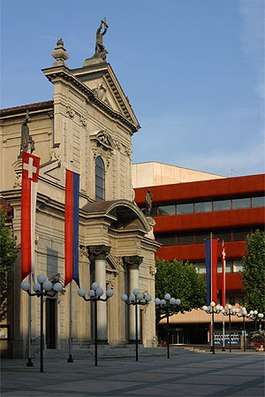 | |
 Coat of arms | |
Location of Chiasso 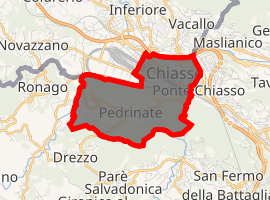
| |
 Chiasso 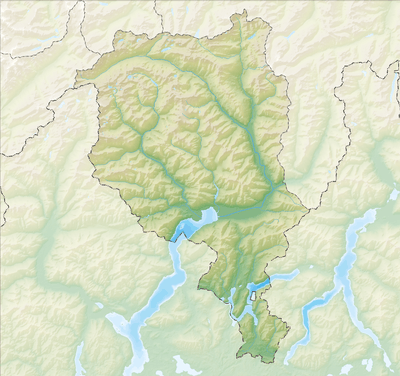 Chiasso | |
| Coordinates: 45°50′N 9°02′E | |
| Country | Switzerland |
| Canton | Ticino |
| District | Mendrisio |
| Government | |
| • Mayor | Bruno Arrigoni |
| Area | |
| • Total | 5.3 km2 (2.0 sq mi) |
| Elevation | 230 m (750 ft) |
| Population (2018-12-31)[2] | |
| • Total | 7,975 |
| • Density | 1,500/km2 (3,900/sq mi) |
| Postal code | 6830 |
| SFOS number | 5250 |
| Surrounded by | Balerna, Cavallasca (IT-CO), Como (IT-CO), Colverde (IT-CO), Morbio Inferiore, Novazzano, Parè (IT-CO), Ronago (IT-CO), Vacallo |
| Website | www SFSO statistics |
As the southernmost of Switzerland's municipalities, Chiasso is located at the border with Italy, in front of Ponte Chiasso (a Frazione of Como, Italy). The municipality of Chiasso includes the villages of Boffalora, Pedrinate and Seseglio.
In 2007, the three mayors of Chiasso, Vacallo and Morbio Inferiore decided to unite into one commune. The new united commune with a population of approximately 15,300 people over a territory of 9.2 km², was rejected by the population in November 2007.
History
Chiasso is first mentioned in 1140 as Claso.[3]
Chiasso (and Boffalora)
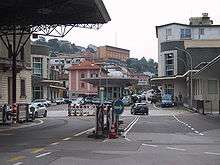
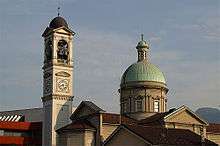
Historically, Chiasso and Boffalora were two distinct agricultural villages. Because of the presence of the nearby Italian border and customs office, and later as part of an access route to the St. Gotthard's Tunnel, the two villages merged and grew.
Chiasso's history and development were strongly influenced by its unique location. During its early history, a castle was built in Chiasso as part of the extended fortifications of the city of Como. It was a suburb of Como, until 1416 when it was incorporated in the Pieve of Balerna and given to the Rusca family to manage. The houses in the village center were owned by the Albrici family and were granted imperial privileges. Chiasso had become an independent community sometime before 1552. In the contemporary documents, it is mentioned as Clasio tabernarum (Chiasso of taverns) referring to its function as a transit point.
Boffalora is mentioned in 1536 as a municipality and remained its independence until the second half of the 17th Century. They became a single parish either in 1657 or 1677.
Chiasso's church belonged to the Pieve of Zezio (in Como), from which it withdrew in the 16th Century. In 1888, Boffalora separated from the parish. It became the seat of an archpriest in 1928. The Church of San Vitale, was first mentioned in 1227, and was rebuilt in 1934.
In the 15th Century Chaisso was known for its horse market. However, the market ended after the invasion of the Swiss Confederation and the march through Chiasso in the War of the League of Cambrai in 1510. In the late 16th Century Chiasso had a small population when compared to other municipalities of the Mendrisiotto valley. The village survived through its role as a border town (providing warehouses and inns) along with income from agriculture and paper mills. In the 19th Century, tobacco and silk factories moved into the town.
The construction of the railway along with income from customs induced an economic and demographic recovery in Chiasso. In 1874 the railway line Lugano-Chiasso opened, followed in 1876 by one running to Como.
In 1910, the Mendrisio electric tramway opened, linking a northern terminus in Riva San Vitale with Capolago, Mendrisio, Balerna and Chiasso. The section of the line in Chiasso closed in 1950 and was replaced by a bus service.[4]
Modernly, a large part of the town is devoted to Chiasso's international railway station and related customs (although some of the border-control responsibilities have been moved to Como, in Italy). There is also a sizeable customs area for traffic passing by road and motorway (both commercial and non-commercial vehicles).
Chiasso offers also a lot of customs related services. A considerable source of revenue for the town is derived from Italians crossing the border to purchase certain goods more cheaply in Switzerland, particularly cigarettes and petrol. It also functions as a banking centre for Italian clients wishing to keep money within the Swiss banking system.
Starting in 1950, Chiasso became an important financial center and the economic center of the Mendrisio region, resulting in a rapid population increase. Since the 1980s, however, population and jobs, especially those in the services sector have shifted into neighboring communities.
The pedestrian zone
In the period of years from 2001 to 2005 a new pedestrian zone has been created, from customs to the municipality building. An enlargement of this zone has been put on the agenda by the local administration, but a referendum about this issue is scheduled on 24 September 2006.
Pedrinate
Pedrinate was first mentioned in 1291 as Pedrenate, but Roman ruins near the village church indicate a much longer history. It was mentioned in 1335 as part of the village cooperative of Seseglio. The village church of S. Stefano is first mentioned in 1545 and was part of the Balerna parish until the 17th century.
Pedrinate municipality was aggregated in the Chiasso municipality in 1975, along with Seseglio. It is located above Chiasso, on the Penz hill. Pedrinate is the most southern village of Switzerland. Around Pedrinate there are some vineyards.
Seseglio
Seseglio is on northern boundary of Chiasso municipality.
Geography
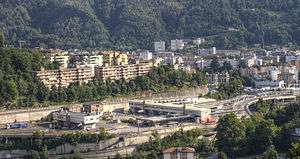
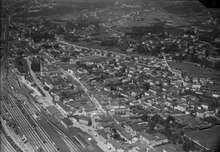
Chiasso has an area, as of 1997, of 5.33 square kilometers (2.06 sq mi). Of this area, 1.63 km2 (0.63 sq mi) or 30.6% is used for agricultural purposes, while 2.65 km2 (1.02 sq mi) or 49.7% is forested. Of the rest of the land, 1.94 km2 (0.75 sq mi) or 36.4% is settled (buildings or roads), 0.02 km2 (4.9 acres) or 0.4% is either rivers or lakes and 0.04 km2 (9.9 acres) or 0.8% is unproductive land.
Of the built up area, industrial buildings made up 1.7% of the total area while housing and buildings made up 18.4% and transportation infrastructure made up 14.4%. while parks, green belts and sports fields made up 1.7%. Out of the forested land, 47.5% of the total land area is heavily forested and 2.3% is covered with orchards or small clusters of trees. Of the agricultural land, 7.9% is used for growing crops, while 4.3% is used for orchards or vine crops and 18.4% is used for alpine pastures. All the water in the municipality is flowing water.[5]
The municipality is located in the Mendrisio district, on the Italian border. Since Pedrinate merged into Chiasso in 1976, it has been the most southerly municipality in Switzerland.
Coat of arms
The blazon of the municipal coat of arms is Argent lion passant holding a letter C gules standing on a carriage entrance azure. The carriage entrance refers to Chiasso location of the ancient road coming from Como and giving access to several places from Chiasso.[6]"
Demographics
Chiasso has a population (as of December 2018) of 7,979.[7] As of 2008, 36.4% of the population are resident foreign nationals.[8] Over the last 10 years (1997–2007) the population has changed at a rate of -2.8%.
Most of the population (as of 2000) speaks Italian (91.3%), with German being second most common (2.5%) and Albanian being third (1.2%).[9] Of the Swiss national languages (as of 2000), 196 speak German, 71 people speak French, 7,048 people speak Italian, and 4 people speak Romansh. The remainder (401 people) speak another language.[10]
As of 2008, the gender distribution of the population was 47.0% male and 53.0% female. The population was made up of 2,226 Swiss men (28.7% of the population), and 1,420 (18.3%) non-Swiss men. There were 2,774 Swiss women (35.7%), and 1,343 (17.3%) non-Swiss women.[11]
In 2008 there were 42 live births to Swiss citizens and 26 births to non-Swiss citizens, and in same time span there were 63 deaths of Swiss citizens and 27 non-Swiss citizen deaths. Ignoring immigration and emigration, the population of Swiss citizens decreased by 21 while the foreign population decreased by 1. There was 1 Swiss man who immigrated back to Switzerland and 3 Swiss women who emigrated from Switzerland. At the same time, there were 104 non-Swiss men and 94 non-Swiss women who immigrated from another country to Switzerland. The total Swiss population change in 2008 (from all sources, including moves across municipal borders) was a decrease of 47 and the non-Swiss population change was an increase of 108 people. This represents a population growth rate of 0.8%.[8]
The age distribution, as of 2009, in Chiasso is; 567 children or 7.3% of the population are between 0 and 9 years old and 586 teenagers or 7.5% are between 10 and 19. Of the adult population, 790 people or 10.2% of the population are between 20 and 29 years old. 1,118 people or 14.4% are between 30 and 39, 1,215 people or 15.7% are between 40 and 49, and 1,008 people or 13.0% are between 50 and 59. The senior population distribution is 996 people or 12.8% of the population are between 60 and 69 years old, 841 people or 10.8% are between 70 and 79, there are 642 people or 8.3% who are over 80.[11]
As of 2000, there were 3,774 private households in the municipality, and an average of 2. persons per household.[9] In 2000 there were 313 single family homes (or 33.3% of the total) out of a total of 940 inhabited buildings. There were 336 multi-family buildings (35.7%), along with 193 multi-purpose buildings that were mostly used for housing (20.5%) and 98 other use buildings (commercial or industrial) that also had some housing (10.4%). Of the single family homes 11 were built before 1919, while 38 were built between 1990 and 2000. The greatest number of single family homes (111) were built between 1919 and 1945.[12]
In 2000 there were 4,498 apartments in the municipality. The most common apartment size was 3 rooms of which there were 1,692. There were 316 single room apartments and 493 apartments with five or more rooms. Of these apartments, a total of 3,763 apartments (83.7% of the total) were permanently occupied, while 181 apartments (4.0%) were seasonally occupied and 554 apartments (12.3%) were empty.[12] The vacancy rate for the municipality, in 2008, was 3.5%.[9] As of 2007, the construction rate of new housing units was 2.4 new units per 1000 residents.[9]
As of 2003 the average price to rent an average apartment in Chiasso was 873.89 Swiss francs (CHF) per month (US$700, £390, €560 approx. exchange rate from 2003). The average rate for a one-room apartment was 491.07 CHF (US$390, £220, €310), a two-room apartment was about 646.96 CHF (US$520, £290, €410), a three-room apartment was about 806.94 CHF (US$650, £360, €520) and a six or more room apartment cost an average of 1544.67 CHF (US$1240, £700, €990). The average apartment price in Chiasso was 78.3% of the national average of 1116 CHF.[13]
The historical population is given in the following chart:[3][14]

Notable people
- Antonio Soldini (1854 in Chiasso – 1933) a Swiss-Italian sculptor
- Serge Brignoni (1903 in Chiasso – 2002) a Swiss avant-garde painter and sculptor
- Marco Grassi (born 1968 in Chiasso) a retired Swiss footballer, played 309 team games and 31 for the Switzerland national team
Sights
The entire village of Chiasso is designated as part of the Inventory of Swiss Heritage Sites[15]
Politics
In the 2007 federal election the most popular party was the FDP which received 29.77% of the vote. The next three most popular parties were the SP (20.42%), the Ticino League (18.12%) and the CVP (16.54%). In the federal election, a total of 2,050 votes were cast, and the voter turnout was 45.6%.[16]
In the 2007 Gran Consiglio election, there were a total of 4,447 registered voters in Chiasso, of which 2,623 or 59.0% voted. 41 blank ballots and 14 null ballots were cast, leaving 2,568 valid ballots in the election. The most popular party was the PLRT which received 698 or 27.2% of the vote. The next three most popular parties were; the PS (with 486 or 18.9%), the SSI (with 456 or 17.8%) and the LEGA (with 406 or 15.8%).[17]
In the 2007 Consiglio di Stato election, 30 blank ballots and 21 null ballots were cast, leaving 2,572 valid ballots in the election. The most popular party was the PLRT which received 668 or 26.0% of the vote. The next three most popular parties were; the PS (with 531 or 20.6%), the LEGA (with 530 or 20.6%) and the SSI (with 417 or 16.2%).[17]
Economy
As of 2007, Chiasso had an unemployment rate of 7.01%. As of 2005, there were 42 people employed in the primary economic sector and about 19 businesses involved in this sector. 880 people were employed in the secondary sector and there were 69 businesses in this sector. 5,549 people were employed in the tertiary sector, with 779 businesses in this sector.[9] There were 3,410 residents of the municipality who were employed in some capacity, of which females made up 42.3% of the workforce.
In 2008 the total number of full-time equivalent jobs was 6,265. The number of jobs in the primary sector was 15, all of which were in agriculture. The number of jobs in the secondary sector was 931, of which 402 or (43.2%) were in manufacturing and 473 (50.8%) were in construction. The number of jobs in the tertiary sector was 5,319. In the tertiary sector; 810 or 15.2% were in wholesale or retail sales or the repair of motor vehicles, 1,550 or 29.1% were in the movement and storage of goods, 208 or 3.9% were in a hotel or restaurant, 84 or 1.6% were in the information industry, 706 or 13.3% were the insurance or financial industry, 684 or 12.9% were technical professionals or scientists, 132 or 2.5% were in education and 365 or 6.9% were in health care.[18]
In 2000, there were 6,532 workers who commuted into the municipality and 1,667 workers who commuted away. The municipality is a net importer of workers, with about 3.9 workers entering the municipality for every one leaving. About 21.4% of the workforce coming into Chiasso are coming from outside Switzerland, while 4.0% of the locals commute out of Switzerland for work.[19] Of the working population, 9.9% used public transportation to get to work, and 47.8% used a private car.[9]
As of 2009, there were 4 hotels in Chiasso with a total of 128 rooms and 281 beds.[20]
Companies based in Chiasso include Lastminute.com Group.
Traffic
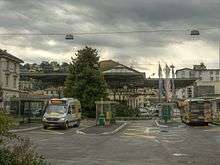
The fortune of Chiasso is mostly linked to its location on the A2; the main route to St. Gotthard's Tunnel, which connects the Southern Alps and Italy with the northern part of Switzerland and Germany.
The A2 Swiss motorway begins at Chiasso. Long traffic queues frequently occur on the motorway around the border where vehicles are being checked for contraband.
Religion
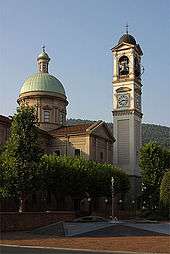
From the 2000 census, 6,235 or 80.8% were Roman Catholic, while 230 or 3.0% belonged to the Swiss Reformed Church. There are 754 individuals (or about 9.77% of the population) who belong to another church (not listed on the census), and 501 individuals (or about 6.49% of the population) did not answer the question.[10]
Education
The entire Swiss population is generally well educated. In Chiasso about 58.1% of the population (between age 25-64) have completed either non-mandatory upper secondary education or additional higher education (either University or a Fachhochschule).[9]
In Chiasso there were a total of 999 students (as of 2009). The Ticino education system provides up to three years of non-mandatory kindergarten and in Chiasso there were 173 children in kindergarten. The primary school program lasts for five years and includes both a standard school and a special school. In the municipality, 300 students attended the standard primary schools and 20 students attended the special school. In the lower secondary school system, students either attend a two-year middle school followed by a two-year pre-apprenticeship or they attend a four-year program to prepare for higher education. There were 249 students in the two-year middle school and 10 in their pre-apprenticeship, while 78 students were in the four-year advanced program.
The upper secondary school includes several options, but at the end of the upper secondary program, a student will be prepared to enter a trade or to continue on to a university or college. In Ticino, vocational students may either attend school while working on their internship or apprenticeship (which takes three or four years) or may attend school followed by an internship or apprenticeship (which takes one year as a full-time student or one and a half to two years as a part-time student).[21] There were 57 vocational students who were attending school full-time and 98 who attend part-time.
The professional program lasts three years and prepares a student for a job in engineering, nursing, computer science, business, tourism and similar fields. There were 14 students in the professional program.[22]
As of 2000, there were 265 students in Chiasso who came from another municipality, while 318 residents attended schools outside the municipality.[19]
Sport
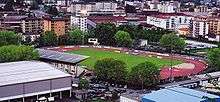
- Football: FC Chiasso
- Stadio comunale
- Ice hockey: HC Chiasso
- Road bicycle racing: Gran Premio di Chiasso (UCI Europe Tour)
References
- "Arealstatistik Standard - Gemeinden nach 4 Hauptbereichen". Federal Statistical Office. Retrieved 13 January 2019.
- "Ständige Wohnbevölkerung nach Staatsangehörigkeitskategorie Geschlecht und Gemeinde; Provisorische Jahresergebnisse; 2018". Federal Statistical Office. 9 April 2019. Retrieved 11 April 2019.
- Chiasso in German, French and Italian in the online Historical Dictionary of Switzerland.
- "Tramvie Madrisiensi". www.eingestellte-bahnen.ch (in German). Archived from the original on 2012-01-05. Retrieved 2012-09-20.
- Altitudine, superficie, secondo il genere di utilizzazione, rilevazione 1992/1997, e densità della popolazione, nel 2000 (in Italian) accessed 25 October 2010
- Flags of the World.com accessed 31-January-2011
- Swiss Federal Statistical Office - STAT-TAB, online database – Ständige und nichtständige Wohnbevölkerung nach institutionellen Gliederungen, Geburtsort und Staatsangehörigkeit (in German) accessed 23 September 2019
- Swiss Federal Statistical Office - Superweb database - Gemeinde Statistics 1981-2008 Archived June 28, 2010, at the Wayback Machine (in German) accessed 19 June 2010
- Swiss Federal Statistical Office Archived January 5, 2016, at the Wayback Machine accessed 31-January-2011
- Popolazione residente, secondo la lingua principale e la religione, nel 2000 Archived July 7, 2011, at the Wayback Machine (in Italian) accessed 23 November 2010
- 01.02.03 Popolazione residente permanente Archived July 7, 2011, at the Wayback Machine (in Italian) accessed 23 November 2010
- Federal Statistical Office STAT-TAB - Datenwürfel für Thema 09.2 - Gebäude und Wohnungen Archived January 21, 2015, at the Wayback Machine (in German) accessed 28 January 2011
- Swiss Federal Statistical Office-Rental prices Archived 2010-04-23 at the Wayback Machine 2003 data (in German) accessed 26 May 2010
- Swiss Federal Statistical Office STAT-TAB Bevölkerungsentwicklung nach Region, 1850-2000 Archived September 30, 2014, at the Wayback Machine (in German) accessed 29 January 2011
- "Kantonsliste A-Objekte:Ticino" (PDF). KGS Inventar (in German). Federal Office of Civil Protection. 2009. Archived from the original (PDF) on 6 July 2011. Retrieved 12 July 2010.
- Swiss Federal Statistical Office, Nationalratswahlen 2007: Stärke der Parteien und Wahlbeteiligung, nach Gemeinden/Bezirk/Canton Archived May 14, 2015, at the Wayback Machine (in German) accessed 28 May 2010
- Elezioni cantonali: Gran Consiglio, Consiglio di Stato Archived July 7, 2011, at the Wayback Machine (in Italian) accessed 23 November 2010
- Swiss Federal Statistical Office STAT-TAB Betriebszählung: Arbeitsstätten nach Gemeinde und NOGA 2008 (Abschnitte), Sektoren 1-3 Archived December 25, 2014, at the Wayback Machine (in German) accessed 28 January 2011
- Swiss Federal Statistical Office - Statweb (in German) accessed 24 June 2010
- Settori alberghiero e paralberghiero Archived July 7, 2011, at the Wayback Machine (in Italian) accessed 23 November 2010
- EDK/CDIP/IDES (2010). KANTONALE SCHULSTRUKTUREN IN DER SCHWEIZ UND IM FÜRSTENTUM LIECHTENSTEIN / STRUCTURES SCOLAIRES CANTONALES EN SUISSE ET DANS LA PRINCIPAUTÉ DU LIECHTENSTEIN (PDF) (Report). Retrieved 24 June 2010.
- Allievi e studenti, secondo il genere di scuola, anno scolastico 2009/2010 Archived July 7, 2011, at the Wayback Machine (in Italian) accessed 23 November 2010
External links
| Wikimedia Commons has media related to Chiasso. |
- (in Italian) Official municipality website
- Chiasso in German, French and Italian in the online Historical Dictionary of Switzerland.